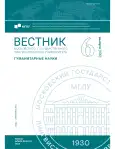Representation of the Emotion "Angst" / "Fear" in German Film Discourse
- Авторлар: Popova M.S.1
-
Мекемелер:
- Moscow State Linguistic University
- Шығарылым: № 6(900) (2025)
- Беттер: 90-97
- Бөлім: Linguistics
- URL: https://journal-vniispk.ru/2542-2197/article/view/301138
- ID: 301138
Дәйексөз келтіру
Толық мәтін
Аннотация
The aim of this study is to examine the emotional concept of “Angst” / “Fear” in German linguaculture as represented in creolized cinematic texts. The analysis focuses on the creolized film text, exploring the nature of interaction and the frequency of use of visual, auditory, and verbal elements in conveying the emotion of “Angst” / “Fear”, using the German film “Das Leben der Anderen” (“The Lives of Others”) as a case study. The findings of the study reveal that the emotion of “Angst” / “Fear” is realized through the following combinations: direct representation of this emotion is achieved through a combination of verbal and visual elements, while indirect representation is based on the interaction of non-verbal and auditory components, which is determined by the mechanisms of emotional perception by the recipient.
Негізгі сөздер
Авторлар туралы
Maria Popova
Moscow State Linguistic University
Хат алмасуға жауапты Автор.
Email: maria_popova_24@mail.ru
Lecturer, Department of Grammar and History of the German Language, Faculty for the German Language
РесейӘдебиет тізімі
- Wierzbicka, A. (1999). Semanticheskie universalii i opisanie yazykov = Semantic universals and description of languages. Trans. by A. D. Shmelev, ed. by T. V. Bulygina. Moscow: Languages of Russian Culture. (In Russ).
- Shakhovsky, V. I. (2008). Lingvisticheskaya teoriya emocij = Linguistic theory of emotions. Moscow: Gnosis. (In Russ).
- Krasavsky, N. A. (2008). Emocional'nye koncepty v nemeckoj i russkoj lingvokul'turah = Emotional concepts in German and Russian linguocultures: monograph. Moscow: Gnosis. (In Russ).
- Pavlenko, A. (2005). Emotions and multilingualism. Cambridge: Cambridge University Press.
- Nelyubina, Yu. A. (2014). Kinotekst v krugu smezhnyh ponyatij = Film text in the circle of related concepts. Humanitarian Vector. Series: Philology, Oriental Studies, 4(40), 26–29. (In Russ).
- Pokrovskaia, N. V. (2022). Film discourse study in foreign linguistics at the beginning of the 21st century. Philological Sciences. Issues of Theory and Practice, 15(3), 936–941. (In Russ).
- Seroshtantova, Yu. S., Chusovlyanova, S. V. (2021). Aspects of transferring emotional information when translating a specialized text (based on a management textbook). Russian Linguistic Bulletin, 4(28), 127–132. (In Russ).
- Paliy, Yu. V., Derevyanko, A. A., Svistunov, A. S. (2022). Lexical means of expressing expressiveness and their reflection in translation. Philological Aspect: International Scientific and Practical Journal, 5(85), 178–187.
- Gorozhanov, A. I. (2025). TV series script as an object of corpus research (based on “Star Trek” saga). Vestnik of Moscow State Linguistic University. Humanities, 3(897), 17–24. (In Russ).
- Zykova, I. V., Krasikova, E. A. (2024). Emotive units in the cinematic discourse from the position of linguistic creativity (the case study of films in English, Russian and Chinese). Vestnik of Saint Petersburg University. Language and literature, 1(21), 182–207. doi: 10.21638/spbu09.2024.110. (In Russ).
- Katermina, V. V., Biryukova, P. S. (2023). Gendernyj potencial neologizmov angloyazychnogo kinodiskursa = Gender potential of neologisms in English film discourse. Krasnodar: Kuban State University. (In Russ).
- Belaya, E. N. (2005). The representation of human emotions in language (literature review for the 80s of the XX – early XX century). Vestnik of Omsk University, 1, 118–121. (In Russ).
- Slyshkin, G. G., Efremova, M. A. (2004). Kinotekst (opyt lingvokul'turologicheskogo analiza) = Film text (an experience of linguocultural analysis). Moscow: Vodolei Publishers. (In Russ).
- Izard, C. E. (1977). Emocii cheloveka = Human emotions. Moscow: Progress. (In Russ).
- Krivolutskaya, M. A. (2018). Linguistic means of expressing the state of fear in L. Petrushevskaya’s works (by the material of the collection “Wanderings regarding death”). Philological Sciences. Issues of Theory and Practice, 12(90), 1, 134–138. DOI doi.org/10.30853/filnauki.2018-12-1.28. (In Russ).
- Zaikina, S. V. (2004). Emocional'nyj koncept «strah» v anglijskoj i russkoj lingvokul'turah: sopostavitel'nyj aspekt = The emotional concept of “fear” in English and Russian linguocultures: а comparative aspect: PhD thesis abstract. Volgograd. (In Russ).
- Ilyin, E. P. (2017). Psihologiya straha = Psychology of fear. St. Petersburg: Piter. (In Russ).
- Griber, Yu. A., Ionauskaite, D., Mor, K. (2019). Cveta emocij: eksperimental'noe issledovanie associativnyh svyazej v sovremennom russkom yazyke = Colors of emotions: An experimental study of associative connections in modern Russian. Litera, 1, 1–18. doi: 10.30853/phil20220149. (In Russ).
- Korganov, T. I., Frolov, I. D. (1964). Kino i muzyka. Muzyka v dramaturgii fil'ma = Cinema and music. Music in film dramaturgy. Moscow: Iskusstvo. (In Russ).
- Ozyumenko, V. I. (2015). Grammatical means of expressing emotions in English discourse. Russian journal of linguistics, 1, 126–143. (In Russ).
Қосымша файлдар










